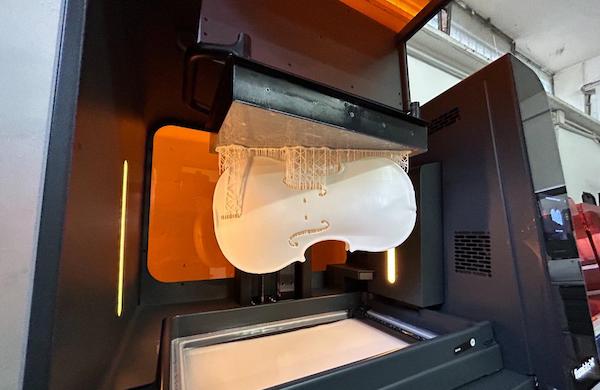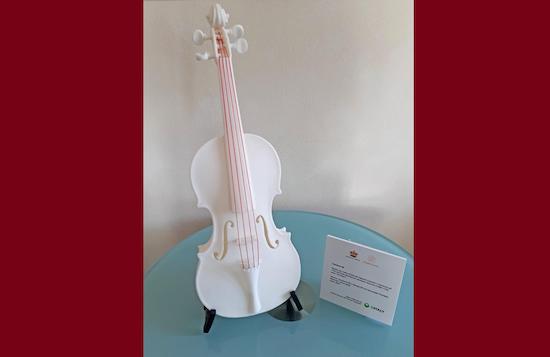
The II Cannone violin that belonged to Niccolò Paganini was scanned and printed for the 70th Premio Paganini Competition. Image courtesy of Premio Paganini Competition.
Latest News
August 17, 2023
One of the star performers at this year’s Premio Paganini Competition, an international violin contest named for the founder of contemporary violin technique Niccolò Paganini, will be a 3D printed version of his vaunted II Cannone violin.
The 70th anniversary of the renowned competition commemorates the significance of the famous violin, which is has been housed at Palazzo Tursi, in the violinist’s hometown, since 1851. The 3D printed replica was made possible through a partnership between the Premio Paganini organization and 3DiTALY, an online 3D printing store and service platform. The 3D printed Paganini violin, which is an exact 1:1 replica of the original instrument, was produced with 3D scanning and SLA technology, using white resin and adorned with red nylon strings—a color scheme designed to mimic the colors of the Saint George’s flag as well as the new logo for the competition’s prize.

The Premio Paganini competition team said the 3D printed version of the Cannone violin is one of the first initiatives to leverage new digital technologies to court a wider audience, in particular, younger music enthusiasts. “The 3D [printed] Cannone is an extra opportunity provided by new technologies, and it can be brought to schools and all over the city to recount Paganini in an unconventional way,” said Marco Bucci, the Mayor of Genoa, Italy, in a press release providing details on the 3D printed violin and the Premio Paganini competition. The 3D printed violin project will be officially presented in October during the 57th gathering of the competition, he said.
Violins have become a hotbed of activity for 3D printing gigs. The Aviva Young Artists Program for young violinists came up with a design for a two-piece, 3D printed violin aimed at making the instrument available for every child, regardless of socioeconomic background. Aviva’s 3D printed violin, which comprises a neck and fingerboard printed in ABS plastic and a body made with a plastic polymer substance, has a printing cost of $7 and an assembled cost of under $30.
University of Auckland Professor Olaf Diegel has developed a following for his unique instruments born from his own work and his day job at the Creative Design and Additive Manufacturing Lab, part of the school’s engineering department. Diegel also makes 3D printed guitars, drums, and other instruments under the moniker ODD Guitars.
There are also open source, 3D printable files available for makers to produce violins on consumer-grade 3D printers, including the Hovalin from Hovalabs. The hovalin was designed with Autodesk Fusion 360 and its shape and dimensions take inspiration from the Stradivarius violin model.
This video showcases the 3D scanning and AM processes that made the 3D printed Premio Paganini Cannone model a reality.
Subscribe to our FREE magazine, FREE email newsletters or both!
Latest News
About the Author
Beth Stackpole is a contributing editor to Digital Engineering. Send e-mail about this article to [email protected].
Follow DE





